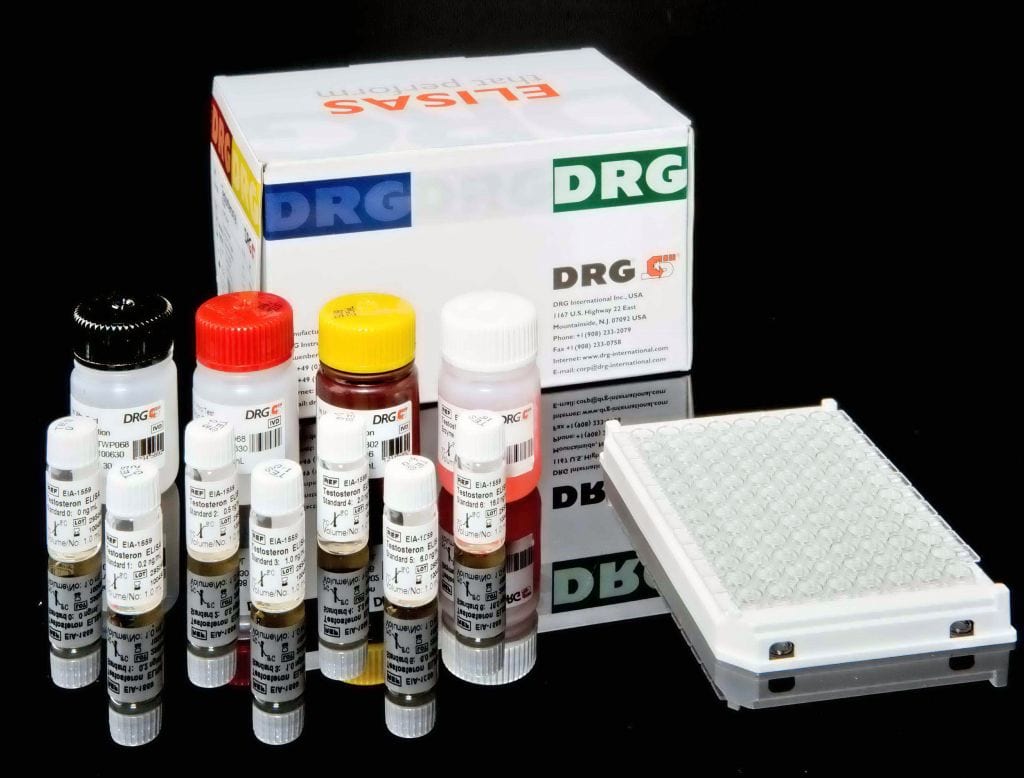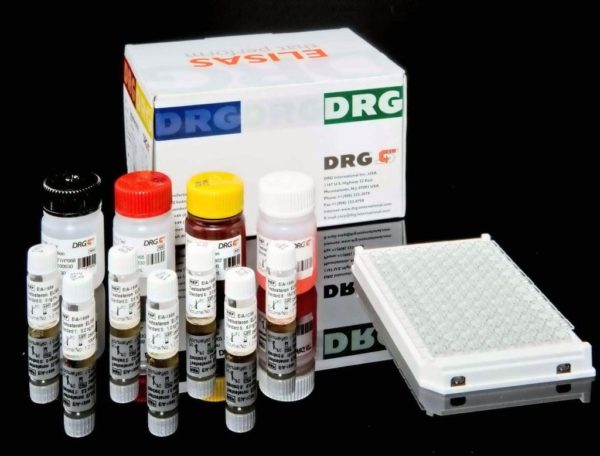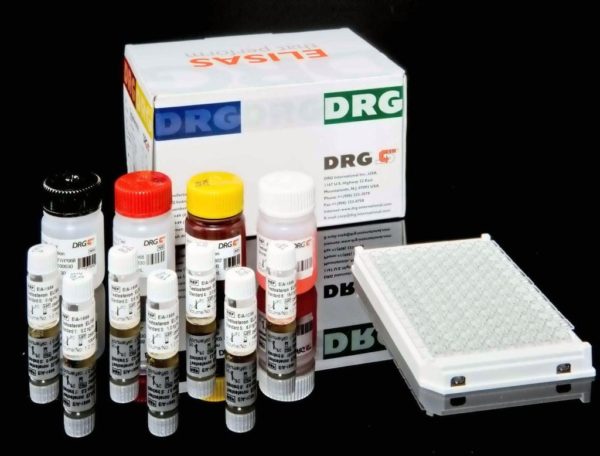Description
Anti-SS-B ELISA is a test system for the quantitative measurement of IgG class autoantibodies against SS-B in human serum or plasma.
This product is intended for professional in vitro diagnostic use only.
Highly purified SS-B is bound to microwells. The determination is based on an indirect enzyme linked immune reaction with the following steps:
Specific antibodies in the patient sample bind to the antigen coated on the surface of the reaction wells. After incubation, a washing step removes unbound and unspecifically bound serum or plasma components. Subsequently added enzyme conjugate binds to the immobilized antibody-antigen-complexes. After incubation, a second washing step removes unbound enzyme conjugate. After addition of substrate solution the bound enzyme conjugate hydrolyses the substrate forming a blue coloured product. Addition of an acid stops the reaction generating a yellow end-product. The intensity of the yellow colour correlates with the concentration of the antibody-antigen-complex and can be measured
photometrically at 450 nm.
Connective tissue diseases (CTD) are a group of autoimmune disorders which are characterized by presence of antinuclear antibodies (ANA) in the blood of patients. ANA are a specific class of autoantibodies that have the capability of binding and destroying certain structures within the nucleus of the cells. These antibodies are involved in the disease pathogenesis, and they also constitute the basis for diagnosis and treatment of CTD.
ANA have been categorized into two main groups:Autoantibodies to DNA and histonesAutoantibodies to extractable nuclear antigens (ENA): Sm, ribonucleoproteins (RNP), SSA/Ro, SSB/La, Scl_70, Jo-1 and PM1 Autoantibodies to DNA and histones include antibodies against single and double stranded DNA (ssDNA and dsDNA). Significant levels of anti-dsDNA antibodies are considered to be confirmatory in the diagnosis of systemic lupus erythematosus (SLE). Anti-histone antibodies are indicative of drug-induced lupus. Besides DNA and histones, autoantibodies may also target other nuclear antigens. These nuclear antigens were named extractable nuclear antigens (ENA), as originally they were extracted from the nuclei with saline solution. Autoantibodies to
Smith antigen (Sm) which is also considered to be highly specific for SLE were the first anti-ENA detected. Thereafter, further subtypes of ENA i.e. ribonucleoproteins (RNP), Sjgren antigen A or B (SSA/Ro or SSB/La), Scl-70, Jo-1 and PM1 were identified. Although most of these ENA are disease specific, a significant overlap exists.
Sensitivity and specificity may also vary depending upon the type of underlying CTD. Presence of autoantibodies in the sera of patients constitutes one of the criteria used
for diagnosis of CTD. Together with the clinical diagnosis ANA subtyping helps in identifying a specific CTD. Indirect immunofluorescence tests (IF) and enzyme immunoassays (ELISA) are commonly used for ANA detection in day to day practice. Initially, screening is carried out by IF-ANA or a generic ELISA which detects ANA of a broad specificity similar to IF-ANA. If positive, more specific tests are performed based on clinical findings and the IF-ANA staining pattern.These antigen specific ELISA assays react with single autoantigens e.g. dsDNA, SS-A/Ro, SS-B/La, Scl-70, Sm, Sm/RNP etc. Autoantibodies to dsDNA are specific and diagnostic for SLE and levels are elevated during active disease. Recently published ACR Guidelines for Screening, Treatment, and Management of Lupus Nephritis recommend the testing of antibodies to dsDNA for monitoring of lupus nephritis, ranging from monthly intervals in pregnant patients with active glomerulonephritis at onset of treatment to every three
months in patients with active nephritis at onset of treatment or pregnant patients with previous but not current nephritis, up to six-monthly testing in patients with previous active nephritis or no prior or current nephritis. SLE-Patients without antibodies against dsDNA often produce antibodies against ssDNA. Similarly anti-Sm is highly specific for SLE but is present in only 10% to 30 % of SLE cases. Antibodies against dsDNA, histones, the 70 kD protein of the U1-snRNP complex (RNP70) and anti Sm are closely associated with SLE. Anti-SSA/Ro and anti-SSB/La antibodies are indicative for Sjgren’s syndrome, but can also be found in up to 30 % cases of SLE with cutaneous involvement. Anti-SS-A/Ro antibodies pass the placenta and may cause the development of SLE in neonates. Anti-SSA/Ro antibodies are almost always present in sera of mothers with babies with neonatal lupus syndrome and with complete congenital heart block. Antinucleolar antibodies are a group of autoantibodies which give a nucleolar IF-staining pattern. Most common of these
are anti-PM-Scl, anti-RNA polymerase I-III and anti-U3-RNP They are found in scleroderma and polymyositis (PM). Antibodies against RNP and the complex RNP/Sm are linked to mixed connective tissue disease (MCTD, Sharp syndrome) and to SLE. Serologically MCTD is characterized by the presence of autoantibodies directed against the 70 kD protein of the U1-snRNP-complex. Up to 100% of MCTD patients manifest high titers of Anti_RNP-70 antibodies.




